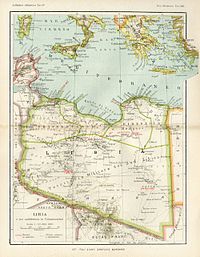Misrata Governorate

Misrata Governorate (or Misurata Province before WW2) was one of the governorates (muhafazah) of Libya from 1963 to 1983. Its capital was the town of Misrata.[1] Initially in the 1930s was called "Provincia di Misurata" of Italian Libya. It was created out of the eastern part of Tripolitania province.
The governorate's population was 145,894 in 1964 and had risen to 156,980 by 1972.[2]
Misurata Provincia[edit]

Before WW2 it was called Provincia di Misurata and had the same extension and capital. it was one of the four provinces of Italian Libya, that were created in 1937 as a "Metropolitan region" of the Kingdom of Italy.[3]
It was divided in 3 sections (called "Circondari" in Italian):
- Misurata
- Zliten
- Khoms (Homs in Italian)
Some villages for Italian colonists were created in this 'province', greatly improving the farm production of the area: the most important was Villaggio Crispi.[4]
The population in the 1939 Census was of nearly 225,000 inhabitants, most of which were Arabs and Berbers. The Italians were nearly 10,000 and were concentrated in Misurata, Homs and some newly created villages [5] for Italian colonists (Gioda, Crispi, Littoriano, Corradini, etc.[6])
Most of the population was Muslim, but there was a growing community of Catholics due to the Italian colonists immigration.[7] Additionally there were nearly one thousand Jews in Misurata.[8]
The province from 1939 was considered officially part of the Kingdom of Italy, with the same laws. It was one of the 4 new Italian provinces of the so-called Quarta Sponda (4th shore) of Mussolini's Greater Italia. Indeed, on January 9, 1939, the colony of Italian Libya was incorporated into "metropolitan Italy" and thereafter considered an integral part of the Italian state (the French, in 1848, had incorporated French Algeria in the same manner).
According to the 1939 Italian Census of Libya,[9] these were the main population data:

| CITY' | INHABITANTS | ITALIANS | NOTES |
|---|---|---|---|
| Littoriano | 150 pop. | 150 | Italian colonists village, now abandoned |
| Corradini | 420 pop. | 420 | Italian colonist village, built in 1939 |
| Homs | 35,316 pop. | 1,156 | Italians nearly 3% |
| Misurata | 46,321 pop. | 1,472 | Italians 3% |
| Gioda | 1,550 pop. | 1,550 | Italian colonists village, built in 1939 |
| Taworgha | 5,174 pop. | - | village populated mostly by Blacks and a few Berbers |
| Sirte | 15,014 pop. | 303 | Italians 2% |
| Nofaliya | 3,459 pop. | 35 | Italians nearly 1% |
| Zliten | 1,300 popo. | 30 | Italians nearly 3% |
Notes[edit]
- ^ Fisher, Morris (1985) Provinces and provincial capitals of the world (2nd edition) Scarecrow Press, Metuchen, New Jersey, page 88, ISBN 0-8108-1758-6
- ^ United States, Department of the Army (1973) "Table 1. Distribution of the Population of Libya, by Governorates 1964 and 1972" Libya (Department of the Army pamphlet 550) Government Printing Office, Washington, D.C. page 60
- ^ Robert Hartley. "Recent population changes in Libya: economic relationships and geographical patterns". Durham University, 1968] ([1])
- ^ Massimo Russo. Libya in the 1950s: Villaggio Crispi. Ed. Orsomax. Roma, 1989
- ^ Massimo Russo (31 August 2008). "Libya in the 50' Villaggio Crispi". Youtube.com. Archived from the original on 2021-12-21.
- ^ "Orsomax OEA villaggi". Orsomax.com. Retrieved 23 May 2017.
- ^ "The Catholic church of Misurata". Paolocason.it. Retrieved 23 May 2017.
- ^ Jews in Libya
- ^ Guida Breve d'Italia Vol. III-Italia Meridionale e Insulare - Libia, C.T.I., Milano, 1939
- ^ Centri rurali di italiani in Libia
Bibliography[edit]
- Del Boca, Angelo. Gli italiani in Libia. Vol. 2. Milano. Mondadori, 1997.
